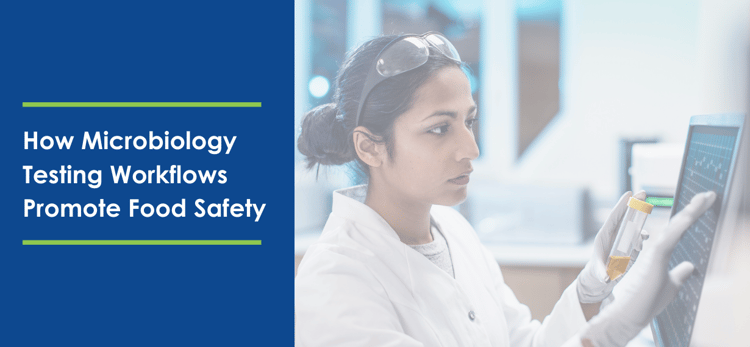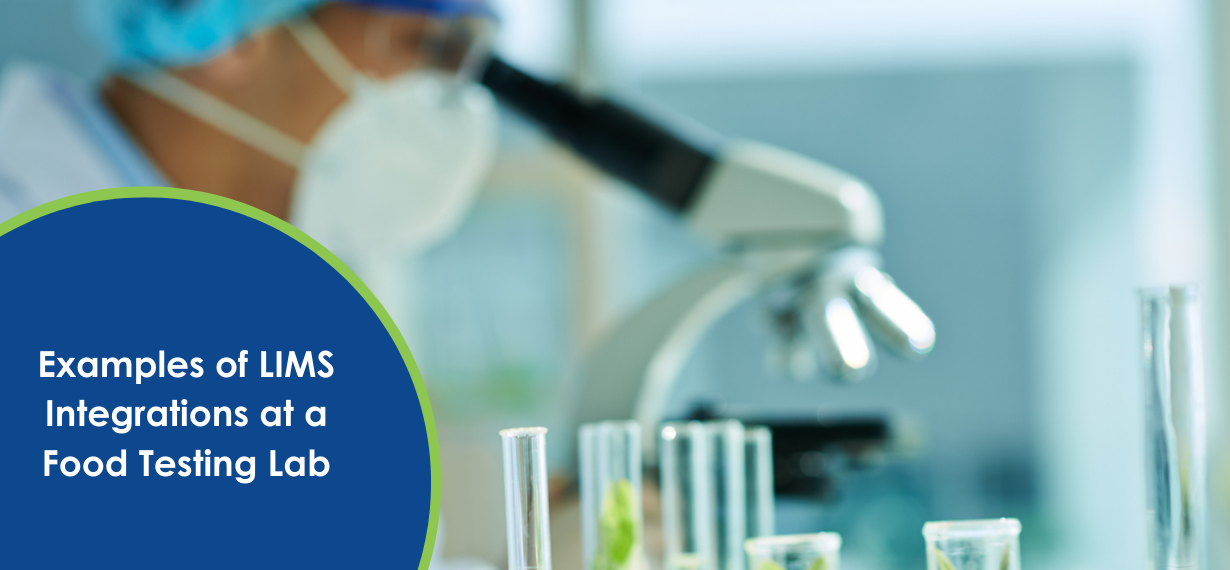
Microbiology testing is essential to guarantee consumer safety in the constantly changing field of food safety. This post will examine the significance of microbiological testing in food and beverage production, along with typical microorganisms tested to guarantee product security.
As technology advances, new methods such as PCR testing for pathogen detection have emerged, offering significant advantages over traditional techniques. We will explore how these modern practices are revolutionizing food safety procedures.
Furthermore, we'll examine how integrating Laboratory Information Management Systems (LIMS) can streamline sample management processes and reduce errors while enhancing data accessibility and traceability. Additionally, this post will highlight the significance of stability studies in determining shelf life predictions and their relation to LIMS implementation.
Lastly, we'll touch upon optimizing lab operations through data visibility and analysis, all essential components in maintaining high standards within microbiology testing for food safety initiatives.
Microbiological Testing in the Food and Beverage Industry
Microbiological testing is essential for ensuring food safety by identifying and detecting different microorganisms present in food products. These tests help to prevent contamination, spoilage, and potential health risks associated with consuming unsafe food. In this section, we will discuss the importance of microbiological testing for consumer protection and common types of microorganisms tested for in the industry.
Importance of Microbiological Testing for Consumer Protection
The principal intent of microorganism testing is to protect consumers from possibly hazardous bacteria that can lead to severe sickness or even fatality. By conducting these tests on raw materials, during production processes, and on finished goods, manufacturers ensure that their products meet stringent quality standards set by regulatory authorities such as the FDA or EU agencies. This not only helps maintain public trust but also prevents costly product recalls due to contamination issues.
Common Types of Microorganisms Tested in the Industry
In order to effectively safeguard against various hazards posed by pathogenic microbes, it's crucial to understand which organisms are most commonly found within specific categories of food items. Some examples include:
- Listeria monocytogenes: Often found in ready-to-eat foods like deli meats or soft cheeses; can lead to listeriosis; a severe infection particularly dangerous for pregnant women, newborns, elderly individuals or those with weakened immune systems.
- E.coli O157:H7: Typically associated with undercooked ground beef; causes bloody diarrhea and kidney failure (hemolytic uremic syndrome) if ingested.
- Salmonella: Commonly linked to raw eggs, poultry or produce; can cause salmonellosis, an infection resulting in diarrhea, fever and abdominal cramps.
- Campylobacter jejuni: Found mainly in raw chicken products; leads to campylobacteriosis characterized by diarrhea (often bloody), nausea and vomiting.
In addition to these well-known pathogens, microbiological testing also helps identify spoilage organisms like yeasts or molds that negatively impact the taste, texture, and appearance of food items. Detecting such microbes early on allows manufacturers to take corrective actions before their products reach consumers' hands.
To sum up, microbiological testing plays a vital role in ensuring the safety of food products within the industry. By identifying potential hazards posed by various microorganisms, companies can prevent contamination issues while protecting public health at large. As we move forward with advancements in technology like PCR testing for pathogen detection (which will be discussed further in our next section), it becomes even more crucial for businesses operating within this sector to stay ahead of emerging threats through rigorous quality control measures supported by reliable laboratory information management systems (LIMS).
Overall, microbiological testing in the food and beverage industry is essential to ensure consumer safety. With that said, PCR technology has revolutionized pathogen detection with its accuracy and efficiency compared to traditional methods.
Key Takeaway: Microbiological testing is crucial for ensuring food safety by identifying and detecting microorganisms in food products. It helps prevent contamination, spoilage, and potential health risks associated with consuming unsafe food. Common types of microorganisms tested include Listeria monocytogenes, E.coli O157:H7, Salmonella, and Campylobacter jejuni.
PCR Testing for Pathogen Detection
Accurate and rapid detection of pathogens is essential in the food and beverage industry to guarantee consumer safety. A groundbreaking technique called Polymerase Chain Reaction (PCR), developed by Dr. Kary Mullis, has revolutionized pathogen detection in microbiological testing.
The Role of PCR Technology in Modern Food Safety Practices
PCR testing involves amplifying specific nucleic acid sequences present within a sample, allowing laboratories to quickly identify harmful microbes such as bacteria, viruses, or fungi. This method provides several advantages over traditional culture-based techniques that can take days or even weeks to yield results. With PCR technology, labs can detect target pathogenic organisms within hours instead of waiting for colonies to grow on agar plates.
Besides its speed advantage, PCR also offers high sensitivity and specificity when identifying microorganisms. By targeting unique genetic markers specific to each organism type, it minimizes false positive results while ensuring that only the relevant pathogens are detected.
Advantages of Using PCR over Traditional Methods
- Rapid Results: As mentioned earlier, one significant benefit of using PCR is its ability to provide fast results compared with conventional culture-based methods which may require days or weeks before conclusive findings emerge.
- Sensitivity & Specificity: The high sensitivity and specificity offered by this technique enable labs not only to accurately identify but also to quantify the presence of various pathogens in samples, an essential aspect when determining if contamination levels exceed regulatory limits set forth by agencies like the FDA or EU authorities (source).
- Versatility: PCR can be applied to a wide range of sample types, including food products, environmental swabs, and water samples. This versatility makes it an invaluable tool for ensuring comprehensive safety testing across the entire production chain.
- Automation Potential: The PCR process is highly amenable to automation, allowing labs to further increase efficiency while reducing human error in their workflows. Integrating automated systems with a Laboratory Information Management System (LIMS) can help streamline operations even more effectively (source).
Incorporating PCR technology into microbiological testing practices has significantly improved the speed and accuracy of pathogen detection within the food and beverage industry. By leveraging this powerful technique alongside other modern tools like LIMS integration, laboratories can better ensure consumer safety by rapidly identifying potential contaminants before they reach store shelves or restaurant tables.
PCR testing for pathogen detection is an essential part of modern food safety practices, providing accurate and reliable results with the help of advanced technology. Moving on, LIMS integration provides a streamlined approach to sample management in microbiology labs by automating processes and reducing errors.
Key Takeaway: PCR testing is a groundbreaking technique for detecting harmful microbes in food and beverage samples, providing fast results with high sensitivity and specificity. It offers versatility in sample types and automation potential, making it an invaluable tool for ensuring comprehensive safety testing across the entire production chain. Incorporating PCR technology into microbiological testing practices has significantly improved pathogen detection accuracy within the industry.
LIMS Integration for Efficient Sample Management
Efficient sample management is crucial in microbiological testing, as it ensures accurate and reliable results while minimizing errors. A Laboratory Information Management System (LIMS) can significantly improve the efficiency of sample processing by automating various tasks and integrating seamlessly with lab instruments such as chromatography data systems. This section will discuss key features of a LIMS solution designed for microbiology labs and how automation reduces errors during sample processing.
Key Features of a LIMS Solution Designed for Microbiology Labs
- Data management: A LIMS centralizes all data related to samples, tests, results, and workflows in one place, making it easier to access and analyze information.
- Sample tracking: With barcode scanning capabilities, a LIMS can track samples from receipt to disposal, ensuring proper documentation at every stage.
- Scheduling & workload distribution: Automated scheduling features help optimize resource allocation by assigning tasks based on staff availability or instrument capacity.
- Instrument integration: By connecting directly with laboratory equipment like PCR machines or spectrophotometers, a LIMS streamlines data transfer between devices without manual intervention.
- User-friendly interface: An intuitive user interface makes it easy for scientists to navigate through the system without extensive training sessions or technical expertise required.
How Automation Reduces Errors During Sample Processing
The introduction of automation within the workflow process minimizes human error associated with manual handling. Here are some ways that automation provided by a well-designed LIMS helps reduce errors during sample processing:
- Elimination of manual data entry: By integrating with lab instruments, a LIMS can automatically capture and store test results, reducing the risk of transcription errors or misinterpretation.
- Standardization of workflows: A LIMS enforces standardized procedures across all laboratory operations, ensuring that tests are performed consistently and accurately regardless of who is conducting them.
- Error-proofing through barcode scanning: Barcode scanning technology enables accurate sample identification and tracking throughout the testing process, preventing mix ups or lost samples.
- Audit trails & version control: With built-in audit trail functionality, a LIMS maintains an accurate record of every action taken within the system, including changes to protocols or test results allowing for easy traceability in case discrepancies arise.
Incorporating a Laboratory Information Management System into microbiology labs not only enhances efficiency but also ensures reliable outcomes by minimizing human error. The integration between lab equipment and software streamlines processes while providing valuable insights into overall performance. As food safety regulations continue to evolve, adopting advanced technologies like LIMS becomes essential for maintaining compliance and staying ahead in this competitive industry.
By integrating LIMS into a microbiology lab, organizations can benefit from improved sample management and error reduction. Additionally, data accessibility and traceability are key features of an effective LIMS solution that ensures compliance with regulations while providing centralized data storage.
Key Takeaway: A Laboratory Information Management System (LIMS) can significantly improve the efficiency of sample processing in microbiological testing by automating various tasks and integrating seamlessly with lab instruments. Key features of a LIMS solution designed for microbiology labs include data management, sample tracking, scheduling and workload distribution, instrument integration, and user friendly interface. Automation provided by a well designed LIMS helps reduce errors during sample processing through elimination of manual data entry, standardization of workflows, error proofing through barcode scanning technology and audit trails and version control.
Data Accessibility and Traceability with LIMS
A well implemented Laboratory Information Management System (LIMS) allows scientists easy access to crucial data while enabling quality managers to track product lots throughout laboratory testing processes. This ensures traceability from raw materials up until finished goods, an important aspect required by regulatory authorities like the FDA or EU agencies.
Benefits of Having Centralized Data Storage System
A LIMS utilized in microbiology labs offers a great advantage of unifying all data storage, allowing personnel to effortlessly access and assess information as needed. With a centralized system, users can:
- Easily search for specific samples or test results within seconds.
- Maintain consistency in data entry formats across multiple instruments and analysts.
- Create custom reports that highlight key performance indicators (KPIs) relevant to their operations.
- Securely store sensitive information with controlled user access levels, ensuring only authorized individuals have access to certain datasets.
Ensuring Compliance with Regulations through Proper Documentation
In addition to improving efficiency and accuracy, a robust LIMS also plays a critical role in helping food safety labs maintain compliance with various regulations such as ISO standards, FDA guidelines, or HACCP principles. By automating many aspects of documentation management, including sample tracking logs, instrument calibration records and analyst training certifications, laboratories can ensure they are meeting industry requirements while minimizing human error risks associated with manual record keeping tasks. Some ways that LIMS helps facilitate regulatory compliance include:
- Automatically generating audit trails for all data modifications, providing a transparent history of changes made to records.
- Enforcing standardized operating procedures (SOPs) by guiding users through each step of the testing process and requiring electronic signatures upon completion.
- Scheduling routine maintenance tasks or calibration events for lab instruments, ensuring they remain in optimal working condition at all times.
In today's fast-paced food industry, having quick access to accurate and reliable microbiological test results is essential for maintaining consumer safety. By integrating a LIMS into their operations, laboratories can streamline workflows while improving traceability throughout the entire product lifecycle, from raw material sourcing up until finished goods distribution. This not only helps labs stay compliant with regulatory requirements but also provides valuable insights that can drive continuous improvement efforts within their organization. To learn more about how LabWare's LIMS solutions can enhance your microbiology lab's efficiency and accuracy, visit our website at LabWare.com.
Data Accessibility and Traceability with LIMS provides a secure, efficient way to store data while ensuring compliance with regulations. Next, we will discussStability Studies & Shelf Life Determination and how it is essential for the food industry as it helps ensure that products remain safe and of high quality over time.
Key Takeaway: A well implemented LIMS enables easy access to crucial data and traceability throughout the laboratory testing process, ensuring compliance with regulatory authorities. A centralized system allows for efficient data storage and retrieval, while automation of documentation management helps minimize human error risks associated with manual record-keeping tasks.
Stability Studies & Shelf Life Determination
Stability studies are a key factor in establishing the shelf life of food and beverage items, guaranteeing that they remain safe to consume despite extended periods under different environmental circumstances such as temperature variations or moisture levels. These studies help manufacturers ensure that their items remain safe for consumption even after prolonged periods under various conditions such as temperature fluctuations or humidity changes. A Laboratory Information Management System (LIMS) can significantly contribute to managing these studies, ensuring that production systems remain sanitary and efficient.
Importance of Stability Studies in the Food Industry
Stability studies are essential for several reasons:
- Safety assurance: By testing products under different environmental conditions, manufacturers can identify potential risks associated with spoilage or contamination over time.
- Regulatory compliance: Regulatory authorities like the FDA and EU agencies require companies to provide evidence supporting their product's shelf life claims through stability data.
- Economic considerations: Accurate shelf life estimates allow businesses to optimize inventory management, reducing waste due to expired goods while maintaining customer satisfaction levels by providing fresh products consistently.
LIMS Contributions to Accurate Shelf Life Predictions
A LIMS solution designed specifically for microbiology laboratories offers numerous benefits when it comes to managing stability study data effectively. Some key advantages include:
- Data centralization: A LIMS consolidates all relevant information related to samples undergoing stability tests into one centralized database. This allows scientists easy access while eliminating manual record keeping errors often encountered during traditional paper-based processes.
- Scheduling automation: The system can automatically schedule testing intervals for each sample, ensuring that tests are conducted at the appropriate times and in accordance with regulatory requirements. This feature reduces the risk of missed or delayed tests, which could lead to inaccurate shelf life estimates.
- Real-time monitoring: A LIMS enables users to track samples throughout their stability study lifecycle, providing real-time updates on test progress and results. By offering instant access to data, a LIMS allows manufacturers to make informed decisions about product quality quickly.
In addition to these benefits, a well implemented LIMS can also facilitate collaboration between different departments within an organization by providing easy access to shared data resources. For example, quality assurance teams can review stability test results as they become available while research and development personnel use this information when designing new products or reformulating existing ones.
To ensure accurate shelf life predictions for food and beverage products using a LIMS solution like LabWare, it is essential that companies invest in proper training for laboratory staff members responsible for conducting stability studies. By combining cutting edge technology with knowledgeable personnel who understand industry best practices regarding microbiological testing procedures and regulatory compliance standards, businesses will be better equipped than ever before when determining how long their goods should remain on store shelves without compromising safety or customer satisfaction levels.
Stability studies and shelf life determination are critical components of food safety, and a LIMS can provide the data needed to make accurate predictions. Leveraging that data for enhanced visibility in lab operations is essential for optimizing workflows, improving productivity, and ensuring quality control.
Key Takeaway: Stability studies are crucial in determining the shelf life of food and beverage products, ensuring safety assurance, regulatory compliance, and economic considerations. A LIMS solution designed for microbiology laboratories can contribute significantly to managing stability study data effectively by centralizing information, automating scheduling, providing real-time monitoring and facilitating collaboration between different departments within an organization.
Enhancing Lab Operations with Data Visibility
In the food and beverage industry, maintaining high levels of safety for both consumers and staff members working within microbiology laboratories is crucial. A well designed Laboratory Information Management System (LIMS) can provide visibility into lab operations capacity and throughput, enabling better decision-making when it comes to resource allocation or process optimization. This results in improved efficiency while ensuring that products remain safe throughout their shelf life.
Identifying Bottlenecks through Data Analysis
A key aspect of enhancing lab operations is identifying bottlenecks that may hinder productivity or compromise sample integrity. By utilizing a LIMS solution like LabWare, laboratory managers can analyze data from various sources such as equipment usage, reagent consumption, and personnel workload to pinpoint areas requiring improvement. For example, if a particular instrument has consistently long queue times due to high demand, management might consider investing in additional equipment or reallocating resources to address this issue more efficiently.
Optimizing Workflows for Increased Productivity
Beyond addressing specific bottlenecks within the laboratory environment, LIMS solutions also offer opportunities for optimizing workflows by automating repetitive tasks and streamlining processes where possible. For instance:
- Data entry automation: Integrating barcode scanners or RFID technology allows quick input of sample information without manual transcription errors.
- Scheduling tools: Advanced scheduling features enable efficient use of shared resources such as incubators or centrifuges by minimizing downtime between runs.
- Electronic signatures & approvals: Implementing electronic signature capabilities reduces paperwork while ensuring compliance with regulatory requirements like FDA's 21 CFR Part 11 guidelines (source).
- Real-time reporting: Access to real-time data allows for proactive adjustments to workflows based on current workload and priorities, ensuring timely completion of critical tasks.
In addition to these workflow optimization strategies, a LIMS can also facilitate collaboration between different departments or even external partners. For example, by providing secure access to relevant data through web-based portals or mobile applications, team members from quality control, production planning, and regulatory affairs can work together more effectively towards shared goals such as product release timelines or compliance audits.
Ultimately, the implementation of a robust LIMS solution like LabWare not only streamlines laboratory operations but also contributes significantly towards maintaining high levels of food safety throughout the entire supply chain. By leveraging advanced technology features and comprehensive data analysis capabilities offered by modern LIMS platforms, microbiology laboratories in the food industry can ensure that they continue delivering safe products while maximizing operational efficiency at every stage of their processes.
Key Takeaway: A well designed Laboratory Information Management System (LIMS) can provide visibility into lab operations capacity and throughput, enabling better decision-making when it comes to resource allocation or process optimization. By utilizing a LIMS solution like LabWare, laboratory managers can analyze data from various sources such as equipment usage, reagent consumption, and personnel workload to pinpoint areas requiring improvement. Beyond addressing specific bottlenecks within the laboratory environment, LIMS solutions also offer opportunities for optimizing workflows by automating repetitive tasks and streamlining processes where possible.
FAQs in Relation to Microbiology Testing Food Safety
What are microbiological tests for food safety?
Microbiological tests for food safety involve analyzing food samples to detect and quantify harmful microorganisms, such as bacteria, viruses, molds, and yeasts. These tests help ensure that the products meet regulatory standards and prevent potential health risks to consumers. Common testing methods include culture-based techniques, PCR (polymerase chain reaction), and rapid detection assays.
How is microbiology related to food safety?
Microbiology plays a crucial role in ensuring food safety by identifying pathogenic microorganisms responsible for spoilage or illness. Microbial contamination can occur at any stage of the production process - from raw materials to finished products. Regular monitoring of microbial levels helps maintain hygiene standards, improve product quality, extend shelf life, and comply with regulatory requirements.
Why is microbiology testing important in the industry?
Microbiology testing is vital in the industry because it safeguards public health by preventing contaminated foods from reaching consumers. It also supports companies in maintaining their reputation by avoiding costly recalls due to unsafe products while meeting legal obligations set forth by regulatory agencies like FDA or EU Commission. Moreover, efficient testing practices contribute towards optimizing production processes and reducing waste.
Conclusion
Microbiology testing is a crucial aspect of ensuring food safety in the industry. By identifying and monitoring microorganisms, companies can protect consumers from harmful pathogens and maintain high-quality products. PCR technology has revolutionized pathogen detection, offering faster and more accurate results than traditional methods.
LIMS integration further streamlines sample management by reducing errors and increasing data accessibility. Stability studies are also essential for predicting shelf life accurately, with LIMS contributing to this process through centralized data storage. Finally, enhancing lab operations through data visibility allows for better workflow optimization.
To learn more about how LabWare's LIMS solutions can help improve microbiology testing and food safety practices in your company, visit LabWare.
















